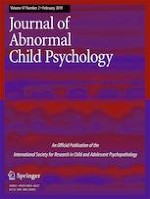15-05-2018
Teacher Involvement Prevents Increases in Children’s Depressive Symptoms: Bidirectional Associations in Elementary School
Gepubliceerd in: Research on Child and Adolescent Psychopathology | Uitgave 2/2019
Log in om toegang te krijgenAbstract
There is accumulating evidence that social relationships can buffer the development of depression in childhood and adolescence. However, few studies have focused on teacher-child relationships in the elementary school years. In addition, research that has examined bidirectional relations between teacher involvement and depressive symptoms is virtually absent in this age period. The participants in this study were 570 children and 30 teachers from 15 elementary schools. Data on children’s depressive symptoms (peer- and teacher-reports) and teacher involvement (teacher-reports) were collected in the fall and spring of Grade 2 and Grade 3 (four waves). As expected, negative cross-time effects of teacher involvement on depressive symptoms were found within grade 2 and 3. In addition, a negative cross-time effect of depressive symptoms on teacher involvement was found in grade 3 only. The results thus indicate the protective role of teacher involvement in the development of depressive symptoms but also suggest that teachers may become less involved over time when they perceive a child as more depressed.
